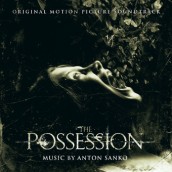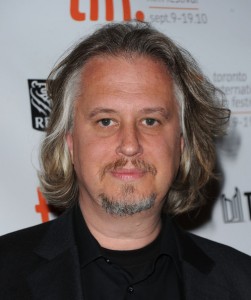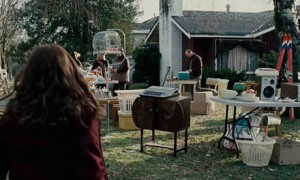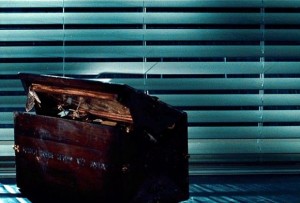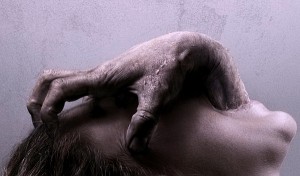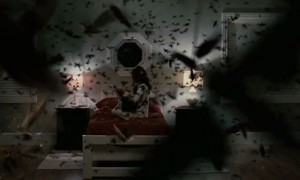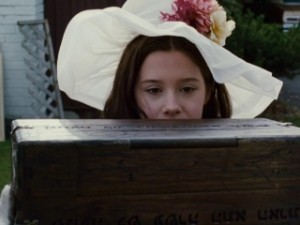When the word “exorcism” is bandied about, the movie-consecrated sights and sounds that seize us are usually comprised of tubular bells, bloodied crucifixes, shrieking dissonance, the shock of grotesquely wrenched bodies, feverish violins and the tormented cries of pubescent girls and their distraught parents. And while THE POSSESSION might have just a few of these stocks in horror trade, what impresses is the leap of faith it’s taken with the same old song and spew- that being of the demon’s transference to the Jewish religion, as trapped inside a “Dybbuk Box” (which once served as the film’s original title). Found at a yard sale by pure young Em (Natasha Calis), this ersatz Pandora inadvertently unleashes a world of Hebraic hurt from the box into her soul, an evil that only her parents (Jeffrey Dean Morgan, Kyra Sedgwick) and an ace rabbinical team can exorcise.
But if there’s one major power that helps to compel this creature out, then it’s the score of Anton Sanko. Relying on haunting melody as opposed to hellish fury, Sanko’s score is possessed with the simplest, poignant emotion of a piano, strings and a music box, a muted tone that steadily bears its fangs with twisted brass, otherworldly percussion and jolting bursts of mania, all given a subtly religious sense of ritual that hearkens back to days of pre-Christian demons. It’s an unusually muted work for the genre that still delivers the horror goods with real intelligence. But then, this kind of intelligent approach has been a trademark of the rising indie composer on his way to bigger symphonic studio stuff, whether his creative progression has been on display in such unnerving genre scores as “Strangeland” and THE LAST WINTER or the unstrung quirkiness of SCOTLAND, PA., DELIRIOUS and the last two seasons of HBO’s BIG LOVE. And while Sanko’s now jumped from the intimacy of RABBIT HOLE for Lions Gate to the studio’s more visceral effort here, Sanko’s ability to capture the emotion of family in crisis is the tie that binds these two scores. It’s a striking musical POSSESSION that’s horror for the heartstrings.
ASSIGNMENT X: It’s been quite a while since Danish director Ole Bornedal has made a Hollywood thriller, the last being 1997’s NIGHTWATCH, which itself was a remake of his original Danish-language picture. What was it like working with Ole as he got back into the swing of things with THE POSSESSION? And do you think him being off that beaten track gave you more leeway to compose something equally different?
ANTON SANKO: What I appreciated most about working with Ole were his European sensibilities. He wasn’t setting out to make your typical Hollywood scare flick – he is much more subtle and studied than that. He supported and welcomed a mix of more traditional writing as well as some more experimental concepts. His musical references ranges from Ligeti to Throbbing Gristle! In one pivotal frightening scene he asked for a single piano note played harder and harder and faster, building the intensity from its minimalism and simplicity. I was a little skeptical at first that it would create the effect that he wanted, but after it was written, I realized it was a fantastic idea, as it fit very well with the framework laid out by the other solo piano cues.
AX: Do you think there’s anything that sets the horror projects you’ve scored like STRANGELAND, THE LAST WINTER and FEAR ITSELF apart from “typical” shockers? And do you think there’s an offbeat quality to your music that made you right for them, and THE POSSESSION?
SANKO: While I think the fact that I had worked on those types of projects made the producers and the director comfortable with hiring me, I think Ole was more interested in some of the work I had done on RABBIT HOLE, as he saw this film as more of a family based drama. For Ole, THE POSSESSION was more an allegory for what happens to a family in a divorce.
AX: While THE UNBORN had the idea of a Jewish exorcism before THE POSSESSION, this is a more traditional horror movie along the lines of THE DYBBUK, especially as the movie’s original title was THE DYBBUK BOX. In that respect, did you do any research yourself into the supernatural realm of Judaism?
SANKO: I did indeed research mystical Judaism – not only to learn more about the subject matter I was about to immerse myself in, but also to learn if there were any specific musical connections I should be aware of.
AX: How culturally “religious” did you want to make your score, as well as ritualistic for the process of an exorcism?
SANKO: I spent a great deal of time studying Jewish music and instrumentation in preparation for writing this score. While I wasn’t able to find a place for specific Jewish instruments, I used a number of altered modes that are prevalent in Jewish music. Those modes can allow for a real duality of emotion – dark and the light that I found suitable for the film. That being said, the further I got into the writing, the more clear it became that what Ole was responding most to was thematic writing, and usually for a large orchestra.
AX: Did you set out to write music that would scare yourself? Or do you think the solitary nature of composing is one that can easily become scary?
SANKO: I absolutely tried to write music that would scare me. The solitary nature of film scoring is indeed scary, but that holds true even if you are writing a romantic comedy.
AX: Could you talk about your main character themes?
SANKO: One Important theme in the film was for Em’s strange attraction to this box. The box had a mystical, magical draw on her, yet there was obviously something really wrong about it. Those scenes were temped with Bartok’s “Music for Strings Percussion and Celesta,” which had been used with such a profound effect in THE SHINING. In order to achieve the mystical, magical, but something’s wrong element, I took a page from the Morricone playbook. In BUGSY, he wrote this lovely, bucolic theme – but it has this great “wrong note” in the brass that pops up every now and again to a marvelous, unsettling result.
Our father character, Clyde, also has a corresponding theme. This theme was one of many I had created during the early writing stages, and then discarded. I had completed writing the first two reels of the film and had nothing for Clyde. My assistant, Joel Thompson, had put this theme up against the scene and we were all very pleasantly surprised at how effective it turned out to be. What I thought worked really well about this piece of music is that even though it’s memorable and melodic it also includes a dissonant passing tone. In this case it resolves without calling a lot of attention to itself, but its presence adds an emotional weight and stress that felt right for Clyde’s emotional state.
AX: How did you want your music to capture the initial innocence of Em, and the emotional voyage her father goes through during her possession?
SANKO: In some ways that transition was built into the scoring process. Many of the scenes earlier on in the movie are emotionally about a family adjusting to their new reality post-divorce and required a more intimate sensibility. As the focus moves shifts from the family dynamic to the supernatural, the orchestra grows larger in scale and the and some of the themes I had hinted at in earlier scenes got to come to the fore in more full throated arrangements. There’s a brilliant scene where Clyde is starting to acknowledge something amiss with Em, marking a turning part in the story. Ole was very clear about wanting a large sweeping melody for this scene, and what I ended up with became a motif that returned several times, culminating in the climax of the movie,
AX: Though it has its dissonant scares, THE POSSESSION’s score is unusually low key and melodic, and all the more classy and effective for it. Did you set out to avoid the kind of over-the-type anti-musical shock effects you usually get for the genre?
SANKO: Thank you! I am, and always have been, a tremendous fan of strong themes in film music. I feel they can provide the audience with an important sub-conscious touchstone throughout the film, as well as provide the necessary emotional impact when called for. Thankfully, Ole felt the same way. Ole was very clear from the start that he never wanted this to be a “genre” horror film. There were a few moments where it was appropriate to explore some dissonant extended techniques with the orchestra, and I always enjoy finding new ways to approach that type of writing, but it was a great experience to jump into the horror genre from a strong melodic standpoint, and everyone was pleased with the results.
AX: For all of its bigger moments, perhaps the most unsettling instrument here is the solo piano. What do you think gives the instrument that kind of power here?
SANKO: Ole allowed the piano to have the room to be such an important element. He wanted to piano to serve almost as an omniscient observer that knows more than the audience does. Ole had a very clear vision for how sound would work in this film and the sound mix was very deftly handled by Marti Humphrey and Chris Jacobson. Working carefully with the sound department let us have the flexibility to allow the music to speak, and speak loudly when it needed to.
AX: Two composers who possess your work here are Bernard Herrmann and John Corigliano, whose uses of romantically lush orchestral suspense and gnarly, hair-raising brass effects are very much part of this score. Was their inspirational intentional?
SANKO: It sometimes feels like Herrmann is part of my DNA. I am a tremendous fan and admirer. For my main “evil” theme the bar I set for myself was to inspire the same sense of dread and inevitability that I always feel when listening to his score from CAPE FEAR, which for me is the pinnacle of a haunting score. And, I did in fact listen to Corigliano for this score (very astute of you to mention that), particularly his Symphony #2. I was also listening to Vasks, Szymanowski, Schnittke and Kilar – a whole raft of Eastern European composers. It seemed that whenever the music had to be at its most terrifying, Ole would mention brass. In one instance he asked for an effect of 10 tuba players destroying their instruments! His direction pushed me to explore new extended techniques for the brass section.
AX: As a fan of the EVIL DEAD movies, what was it like working on a movie produced by Sam Raimi. Did you have any interaction with him?
SANKO: You’re right – I am a tremendous fan of the Evil Dead series as well as all of Sam Raimi’s work. It was an incredible honor to know that he was involved in the selection process that got me hired. Although, sadly, I never had the opportunity to interact with him, I was very pleased to learn that his first comment after viewing the completed project was “that’s a fantastic score”!
AX: THE POSSESSION is your most accomplished, and biggest orchestral score yet. How difficult is it to move up the ladder from starting out as an “indie” composer of small-scale scores to get to this point, both artistically and career-wise?
SANKO: Good question. And not easily answered. Obviously, each film is an incredible opportunity to grow as an artist and craftsman. I try to do something new that takes me out of my comfort zone with every new project. Hopefully THE POSSESSION shows the culmination of some of that experience. It’s really a treat to be able to put together an ensemble of this size and take advantage of the power and emotional impact that a large orchestra has. We used an extended low end in the orchestra to add weight in certain key moments – the effect of that many players moving air in a big room has a certain visceral impact that is undeniable. In some ways, scoring for indie films can be much more challenging because you are working on films that are often dialog intensive and sometimes emotionally oblique. You can learn a lot by walking those fine lines.
AX: Does scoring a movie like this make your more of a “believer?”
SANKO: I learned that days after the initial filming of THE POSSESSION was completed, a massive fire consumed the warehouse containing all the props used in the film including the box itself. That certainly got my attention.
AX: THE POSSESSION is supposed to be based on a true story. Do you know what really happened, or did you want to ask?
SANKO: The true story is actually very well documented. It originally appeared as an auction item on Ebay. (In fact, here is the original listing: DYBBUK BOX EBAY LISTING
The seller was a college student who had a purchased it at a yard sale. He and subsequent owners were plagued by horrible luck and strange paranormal events. After learning about it, the LA Times wrote an article called “A Jinx in a Box” There’s also a Wikipedia entry: WIKIPEDIA DYBBUK BOX
In short, if presented with a Dybbuk Box as a gift, I would strongly advise re-gifting it to a person you are not terribly fond of!
Click on Link: Buy Anton Sanko’s POSSESSION score
Related: Movie Review: THE POSSESSION
AGREE? DISAGREE? LET YOUR VOICE BE HEARD – COMMENT BELOW
Follow us on Twitter at ASSIGNMENT X
Fan us on Facebook at ASSIGNMENTX
Article Source: Assignment X
Article: Interview with THE POSSESSION composer Anton Sanko
Related Posts:




